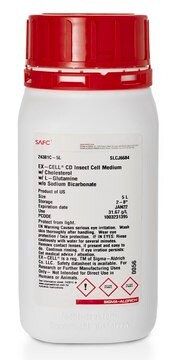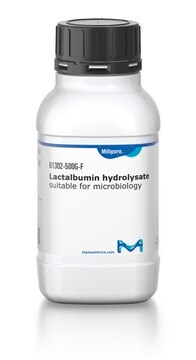S9895
Schneider′s Insect Medium
With L-glutamine, without calcium chloride and sodium bicarbonate, powder, suitable for insect cell culture
Synonym(s):
Schneider’s Drosophila Medium
About This Item
Recommended Products
Quality Level
form
powder
concentration
24.5 g/L
technique(s)
cell culture | insect: suitable
components
glucose: 2 g/L (Dextro)
NaHCO3: no
L-glutamine: 1.8 g/L
shipped in
ambient
storage temp.
2-8°C
Looking for similar products? Visit Product Comparison Guide
Related Categories
1 of 4
This Item | S8398 | S0146 | 24381C |
|---|---|---|---|
| form powder | form powder | form liquid | form dry powder |
| components glucose: 2 g/L (Dextro) | components NaHCO3: no | components NaHCO3: 0.4 g/L | components L-glutamine: yes |
| storage temp. 2-8°C | storage temp. 2-8°C | storage temp. 2-8°C | storage temp. 2-8°C |
| shipped in ambient | shipped in ambient | shipped in ambient | shipped in ambient |
| Quality Level 500 | Quality Level - | Quality Level 400 | Quality Level 500 |
General description
Application
SCHNEIDER′S INSECT MEDIUM is one of the cell culture media available from Sigma. The selection of a nutrient medium is strongly influenced by 1] type of cell, 2] type of culture [monolayer, suspension, clonal] and 3] ° of chemical definition necessary. It is important to review the literature for recommendations concerning medium, supplementation and physiological parameters required for a specific cell line.
Preparation Note
Supplements can be added prior to filtration or introduced aseptically to sterile medium. The nature of the supplement may affect storage conditions and shelf life of the medium.
1.Measure out 80% of final required volume of water. Water temperature should be 15-20 °C.
2.While gently stirring the water, add the powdered medium. Stir until dispersed. Material will not go in solution completely. Do NOT heat water.
3.Rinse original package with a small amount of water to remove all traces of powder. Add to solution in step 2.
4.To the solution in step 3, add 0.4 g sodium bicarbonate or 5.3 ml of sodium bicarbonate solution [7.5% w/v] for each liter of final volume of medium being prepared. Stir until dissolved.
5.While stirring, adjust the pH to at least 9.2 ± 0.2 with sodium hydroxide. Stir for a minimum of 10 minutes. Solution may become turbid.
6.While stirring, adjust the pH to 6.7 ± 0.2 with HCl, solution will clear.
7.Prepare a calcium chloride solution by dissolving 0.6 g of anhydrous calcium chloride [C5670] in 50 ml of tissue culture grade water for EACH liter of final volume of medium being prepared. Slowly add the calcium chloride solution dropwise to the medium with rapid mixing to avoid precipitate formation.
8.While stirring, adjust the pH of the medium to 0.1-0.3 pH units below the desired pH since it may rise during filtration. The use of 1N HCl or 1N NaOH is recommended.
9.Add additional water to bring the solution to final volume.
10.An osmotic pressure of 360 mOsm ± 5% is suitable for the growth of cells derived from Drosophila melanogaster. If desired the osmotic pressure can be increased 10 mOsm by adding potassium chloride (0.4 g salt OR 2 ml of a 20% (w/v) solution) OR sodium chloride (0.3 g of salt OR 2 ml of a 15% (w/v) solution) for EACH liter of final volume of medium being prepared. The osmotic pressure can be decreased 10 mOsm by adding 27.8 ml of water for EACH liter of final volume of medium being prepared. Stir until dissolved.
11.Sterilize immediately by filtration using a membrane with a porosity of 0.22 microns or less.
12.Aseptically dispense medium into sterile container.
accessory
also commonly purchased with this product
supplement
Signal Word
Danger
Hazard Statements
Precautionary Statements
Hazard Classifications
Eye Dam. 1
Storage Class Code
11 - Combustible Solids
WGK
WGK 3
Choose from one of the most recent versions:
Already Own This Product?
Find documentation for the products that you have recently purchased in the Document Library.
Customers Also Viewed
Our team of scientists has experience in all areas of research including Life Science, Material Science, Chemical Synthesis, Chromatography, Analytical and many others.
Contact Technical Service








